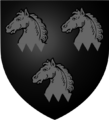Brochwel Ysgithrog facts for kids
Quick facts for kids Brochwel Ysgithrog |
|
|---|---|
| King of Powys | |
| Reign | c. 540–c. 560 |
| Predecessor | Morgan ap Pasgen |
| Successor | Cynan Garwyn |
| Died | 560 |
| Spouse | Arddyn Benasgel (Arddun Penasgell) |
| Issue | Cynan Garwyn, Saint Tysilio |
| House | House of Gwertherion |
| Father | Cyngen Glodrydd |
| Mother | St. Tudlwystl (daughter of Brychan ap Gwyngwen ap Tewdr) |
| Occupation | King |
Brochwel Ysgithrog was a powerful king who ruled the ancient kingdom of Powys in eastern Wales. He lived around the 6th century, dying about the year 560. His full name was Brochwel son of Cyngen.
Brochwel had a special nickname, Ysgithrog. This word is a bit old, but it means something like "of the canine teeth" or "the fanged one." People think he got this name because he might have had large teeth, or perhaps he wore a helmet with horns. Most likely, it was because he was known for being a very strong and aggressive leader.
Contents
Brochwel's Family and Life
Brochwel's father was King Cyngen Glodrydd. His mother was St. Tudlwystl. She was the daughter of another important person named Brychan.
Brochwel married a woman named Arddyn Benasgel. Her name sometimes appears as Arddun Penasgell, which means "Wing Headed." She was the daughter of King Pabo Post Prydain.
Brochwel and Arddyn had two sons. One was Cynan Garwyn, who later became a king himself. Their other son was Saint Tysilio. Tysilio was a religious leader who helped start an old church in a place called Meifod.
Stories and Traditions About Brochwel
Even though Brochwel was an important king, we don't have many detailed records about his time as ruler. However, many old Welsh poems and stories talk about him. These poems were written much later, some even hundreds of years after he lived.
In these stories, Brochwel is shown as a brave warrior and a ruler of a large area. He was said to love hunting very much. One of his favorite places to hunt was the Vale of Meifod. He even made Meifod his "May-Abode," which means it was his summer home.
When he visited his summer home, he often went to a holy place dedicated to Saint Gwyddfarch. Brochwel also gave his son, Saint Tysilio, an important role as a bishop in his kingdom. Both Brochwel and Tysilio are connected to the founding of the Church at Meifod. However, the stones of the church you see there today are not from their time.
Brochwel's Coat of Arms
Later on, a special design was created for Brochwel. This design is called a coat of arms. It features three black horse heads on a silver background. Some people believe these horse heads might represent the white horses of the Saxons that were defeated in battle.
Many families in the area later claimed to be related to Brochwel. They would often include his coat of arms in their own family designs. This shows how important and respected Brochwel was in history.
An old book from 1584 described Brochwel as a powerful leader who lived in a town called Pengwern Powys. Today, that town is known as Shrewsbury (Salopia). The book even said his house was where St. Chad's College now stands.
Pengwern was a real Welsh kingdom or royal home, likely in Shropshire. It's not completely clear if Brochwel ruled there. Some people believe he was buried in St. Chad's College in Shrewsbury, a place he might have helped build. Others think he was buried in Pentrefoelas in Gwynedd. A grave found there, belonging to a tall man, has a stone with the name 'Brohomagli' on it, which is similar to Brochwel.
Images for kids


